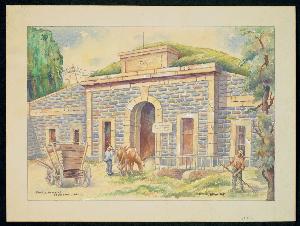Baehr, Henry
Baehr, Henry;Behr, Henry
Place: Cologne
Born: 1897
Death: 1981
Biography:
Early Life and Career
Henry Baehr, a German painter, was born in 1897 and lived a life marked by both creativity and hardship. He immigrated to the United States in 1946, after experiencing the turmoil of World War II. Baehr's wife and he were held at Theresienstadt concentration camp for three and a half years, and later spent six months in a Displaced Persons camp in Deggendorf, Bavaria.
Artistic Style and Notable Works
Baehr is known for his artwork depicting life in the Theresienstadt concentration camp, including "Theresienstadt, Men's Quarters, L-306". His paintings are a testament to the human spirit's ability to create beauty amidst adversity. Baehr's style is characterized by bold colors and emotional depth, reflecting his experiences during the war.
Inspiration and Influence
Baehr's work can be seen in the context of other artists who have explored the human experience through art. For example, Gustav Klimt's "Allegory of Sculpture" also explores the relationship between art and the human form. Baehr's paintings can be found on Wikioo.org, alongside other notable artists such as Hans Holbein The Younger and his works like "Portrait of Charles de Solier Lord of Morette".
Legacy and Impact
Baehr's legacy is a testament to the power of art to transcend suffering and hardship. His paintings serve as a reminder of the importance of resilience and creativity in the face of adversity. Baehr's story can be found on Wikioo.org, where his artwork is showcased alongside other notable artists.
- Henry Baehr's paintings are a powerful reminder of the human experience during World War II.
- His artwork can be found on Wikioo.org, alongside other notable artists.
- Baehr's legacy is a testament to the power of art to transcend suffering and hardship.
Baehr's life and artwork serve as an inspiration to artists and art lovers alike, reminding us of the importance of creativity and resilience in the face of adversity. His paintings can be found on Wikioo.org, where they continue to inspire and educate audiences around the world.



